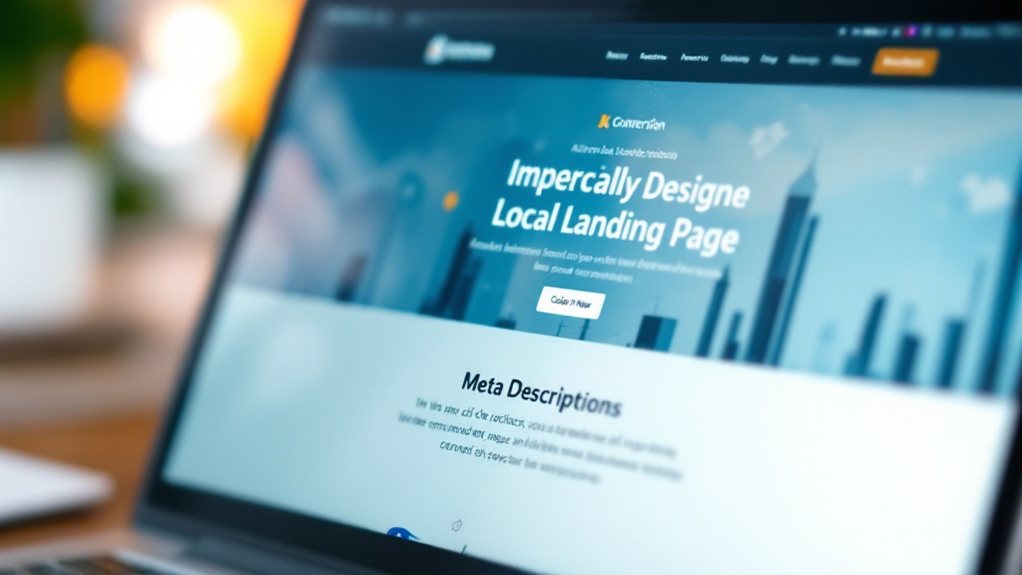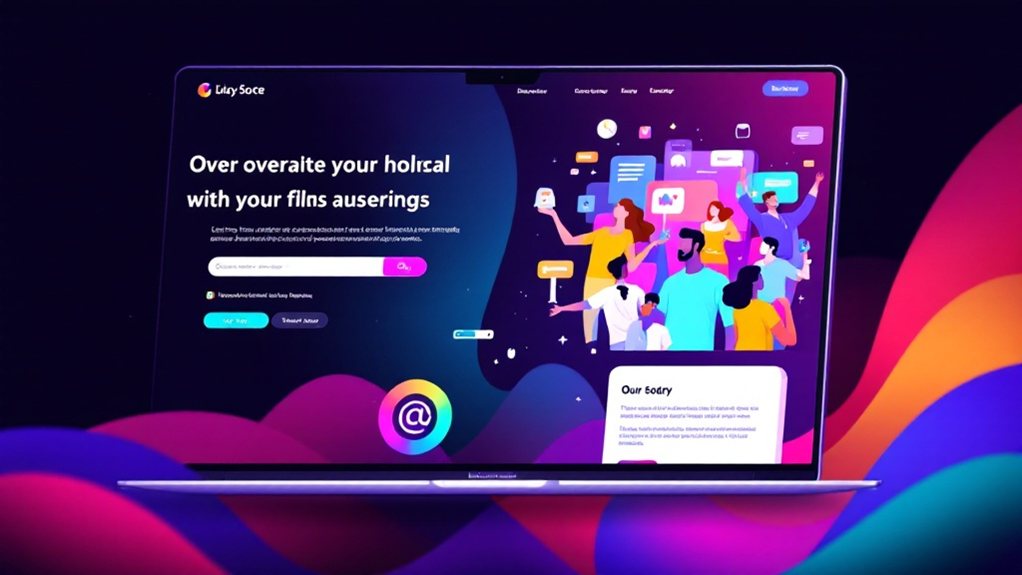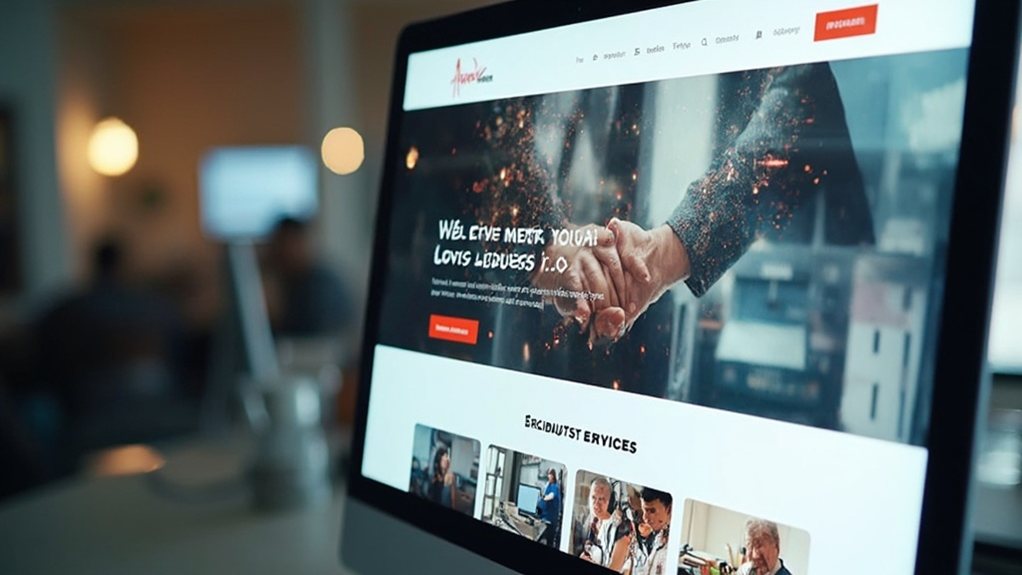To optimize your local landing pages for conversions, craft compelling title tags and meta descriptions that incorporate relevant keywords and encourage clicks. Localize your content to resonate with your target audience, and conduct thorough keyword research to identify terms that match search intent. Maintain consistent NAP information across platforms, enhance user experience with intuitive navigation, and leverage visuals to build trust and authenticity. Implement effective calls to action, and continuously monitor performance to refine your strategies. Discover more advanced tips to boost local landing page conversions.
Crafting Captivating Title Tags

Crafting effective title tags is a critical component of local landing page optimization. Your title tags are a key factor in capturing user attention and summarizing your page's content. Perform thorough keyword research to identify relevant local terms and incorporate them into your title tags. Be sure to include your main keyword and location for local SEO. Keep titles under 70 characters to prevent truncation. Incorporate context that encourages clicks in a natural manner, using relevant details like the year or seasonal offers. Structure your titles to match search intent, indicate the city or region, and provide a clear overview. Avoid keyword stuffing, and monitor performance to optimize further. With strategic title tags, you can drive more qualified traffic and boost conversions for your local business.
Optimizing Meta Descriptions for Conversions

Having established the importance of crafting captivating title tags, let's now explore how you can optimize your meta descriptions to drive more conversions. Treat your meta descriptions as miniature ads, including primary keywords to improve relevance and appeal to potential users. While Google frequently rewrites these, optimizing for long-tail keywords can reduce rewriting frequency. Craft meta descriptions that are clear summaries within the 155-character limit, using compelling language to attract clicks. Ensure relevance to the page content, and target your audience's needs by incorporating location-specific keywords for local landing pages. By following these strategies, you can boost click-through rates and conversions on your local landing pages. Regularly reviewing and updating meta descriptions is vital to maintain SEO relevance.
Localizing Content for Targeted Audiences

To drive conversions, you must localize your content to resonate with targeted audiences. Localization can improve sales by 40-50% and reduce inventories/markdowns. Tailor your messaging, visuals, and offers to their preferences and needs. This audience-centric approach will optimize the relevance and impact of your local landing pages.
Audience-Centric Content
Tailoring your content to resonate with local audiences is key to driving meaningful conversions. Identify local preferences and highlight your business's involvement in the community. Emphasize your unique selling points and location-specific services to showcase why you're the best choice. Incorporate customer feedback to demonstrate responsiveness. Focus on what makes your area appealing, address local concerns, and explain why you chose this location. Optimize for high-intent keywords like "near me" and showcase local reviews to build trust. Leverage schema markup, unique meta tags, and local search trends to enhance visibility. Highlight local credibility, community testimonials, and your long-term commitment to the area. Responsive customer service tailored to local preferences will further solidify your connection with the audience.
Optimizing Local Relevance
Optimizing local relevance is crucial for connecting with your targeted audience and driving meaningful conversions. Ensure your content highlights the local landmarks, attractions, and events that resonate with your community. Weave in geographic keywords naturally throughout your pages, and leverage structured data to help search engines better understand your local focus. Maintain consistent NAP (name, address, phone) information across all platforms to solidify your business's local credibility. Nearly 3 out of 10 Google SERPs contain a local pack in the results. Tap into the power of long-tail and voice search-friendly keywords to capture high-intent local queries. Fostering community engagement through local partnerships and event coverage can further boost your trustworthiness and relevance within your target market.
Conducting Effective Keyword Research
Conducting effective keyword research is crucial for optimizing your local landing pages. Start by analyzing your core services and products, then expand your keyword list with location-specific modifiers. Local keywords are highly relevant as they include a location component. Leverage powerful tools like SEMrush and Ahrefs to uncover long-tail keywords that can drive qualified traffic to your pages.
Comprehensive Keyword Analysis
Effective keyword research is the foundation of any successful local landing page optimization strategy. Tools like Ahrefs, SEMrush, and Google Keyword Planner provide in-depth data on search volume, intent, and competition – crucial for identifying the right keywords to target. Understanding search intent is key to succeeding in keyword research, beyond just focusing on high-volume keywords. Distinguish between primary, long-tail, and semantically-related keywords to cover different user queries. Evaluate factors like search intent, difficulty, and your website's authority to prioritize the most impactful keywords. Advanced techniques like LSI, keyword clustering, and SERP analysis can uncover hidden opportunities. Integrate keywords naturally, optimize meta tags, and structure content for maximum SEO impact. With a comprehensive keyword strategy, you'll drive more qualified traffic and conversions to your local landing pages.
Location-Specific Keyword Targeting
When targeting location-specific keywords, you'll want to leverage tools like Google Keyword Planner and SEMrush to uncover relevant terms with local intent and sufficient search volume. Analyzing competitor keyword strategies can help identify gaps and opportunities, and incorporating location identifiers like city names, neighborhoods, or regional terms into your content. Tailor keywords to your specific services or products to improve targeting precision. Emphasizing the unique attributes of each local market can help create differentiated content that resonates with the target audience.
Leverage Local Insights | Analyze local demographics, interests, and behaviors to inform keyword selection.
Monitor Community Engagement | Engage with local online communities to understand how they describe products or services.
Identify Trending Topics | Monitor local news and forums to identify popular search terms.
Emphasize Unique Attributes | Create differentiated content for each location, highlighting the unique aspects of the local market.
Long-Tail Keyword Optimization
Thorough keyword research is the foundation for driving organic traffic and creating content that resonates with your target audience. Utilize tools like Ahrefs, Semrush, and Google Keyword Planner to uncover long-tail keywords relevant to your local market. Long-tail keywords are more detailed, specific phrases with three or more words. These specific phrases have lower search volumes but higher conversion potential due to their targeted nature. Integrate long-tail keywords naturally into your landing page content, including titles, headings, and body copy. Ensure your content aligns with the search intent behind these keywords. Leverage internal linking with long-tail anchor text to enhance visibility. Monitor performance and adjust your strategies accordingly. Optimizing for long-tail keywords is key to driving qualified traffic and boosting conversions on your local landing pages.
Maintaining Consistent NAP Across Platforms
Maintaining a consistent NAP (name, address, and phone number) across platforms is crucial for local SEO success. Consistent NAP signals to search engines that your business is legitimate and trustworthy, improving your local search rankings. To achieve this, you should:
- Ensure your NAP is accurate and uniform across your website, social media profiles, and local directories.
- Claim and regularly update your listings on platforms like Google My Business and Bing Places.
- Routinely audit your listings to identify and correct any inconsistencies.
- Maintain a centralized record of your business information to expedite updates.
Consistent NAP data builds customer trust and enhances your online credibility, giving you a competitive advantage in local search results.
Structuring Content for Voice Search Optimization
Optimizing your local content for voice search starts by focusing on conversational language. Craft content that mirrors how users ask questions in everyday speech. Incorporate long-tail keywords in your writing, such as "best Italian restaurants in New York," to match common voice queries. Answer FAQs that address typical voice search inquiries, and frame content around question-based keywords like "who," "what," and "where." Emphasize location-specific information to align with local voice searches. Use natural language in meta titles, include location in descriptions, and highlight the benefits users gain from your content. Develop location-specific pages, leverage local keywords, and link to relevant local landing pages to enhance voice search optimization.
Enhancing User Experience With Internal Linking
Effective internal linking not only elevates your site's user experience, but also bolsters your local landing page optimization efforts. By guiding visitors to relevant content, internal links enhance engagement and increase session time. Moreover, they can direct users to conversion-oriented pages, potentially boosting your conversion rates. To maximize their impact, craft compelling anchor text and strategically place links, ensuring a balanced link density. Utilize tools like Google Search Console and Google Analytics to track the effectiveness of your internal linking strategy.
- Facilitate easy navigation through user-friendly design
- Reduce bounce rates by directing users to relevant content
- Improve overall site interaction with clear and intuitive navigation
- Maintain user engagement by connecting them to valuable information
Leveraging Visual Elements for Authenticity
Compelling location-specific imagery can captivate your audience and establish your business as a trusted local presence. Strategically leveraging geotagged photos and videos showcases your community involvement, reinforcing your authenticity. Integrating these visual elements seamlessly into your local landing pages can drive deeper engagement and conversions.
Impactful Location-Specific Imagery
When leveraging visuals to cultivate authenticity, original photography of your local premises and staff can foster a sense of community connection. Ensure your images are instantly recognizable to locals, resonating with your target audience and building trust. Showcase close-up visuals of your team in action or as professional headshots to establish familiarity. Consider offering immersive experiences, such as videos or 360° tours, to enhance engagement.
- Use location-specific imagery as trust signals to reinforce your credibility and expertise.
- Integrate local landmarks and events to strengthen community ties and improve your business reputation.
- Position high-quality images above the fold to capture immediate attention and optimize for mobile responsiveness.
- Hire a professional photographer to capture unique visuals that reflect your local environment.
Leveraging Geotagged Media
Geotagged media can be a powerful tool in your local marketing arsenal, building upon the authenticity established through location-specific imagery. By embedding geographical data into your visuals, you'll demonstrate a tangible presence in the community, boosting trust and credibility with potential customers. Search engines will also reward this contextual relevance, potentially improving your local SEO. Furthermore, geotagged media can create a more personalized experience, engaging viewers in your target areas. Leverage tools like Lightroom or online services to add geolocation data, ensuring consistent metadata across all visuals. Incorporate this authentic content strategically to guide your audience and drive higher conversions on your local landing pages.
Implementing Effective Calls to Action
Implementing effective calls to action (CTAs) is crucial for boosting conversions on your local landing pages. Use a single, clear CTA to avoid confusing visitors, and incorporate action-oriented language like "Download" or "Sign Up." Tailor your CTAs to address user needs directly, and leverage urgency with phrases like "Act Now" to drive immediate action. Position your CTAs above the fold for maximum visibility, and ensure they are visually appealing with contrasting colors and larger button sizes.
- Use direct, benefit-focused language in your CTAs
- Test and analyze CTA performance to refine your strategy
- Incorporate local keywords and community-focused messaging
- Provide relevant content to support and enhance your CTAs
Monitoring Performance and Refining Strategies
Monitoring the performance of your local landing pages is key to optimizing for higher conversions. Use Google Analytics to track metrics like page views, bounce rates, and average session duration. Leverage event tracking and goal tracking to measure specific user actions. Analyze heatmaps and session recordings to identify friction points in the user experience. Conduct usability testing and conversion funnel analysis to uncover drop-offs. Compare high and low-performing elements to refine your strategies. Monitor user engagement metrics and study your competitors to adapt successful tactics. Continuously refine your content by optimizing meta tags, imagery, and local references. Optimize for mobile and test different layouts to boost conversion rates.
